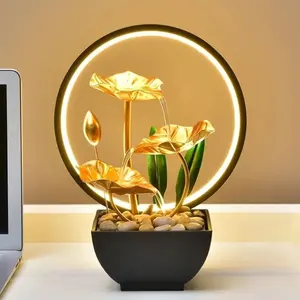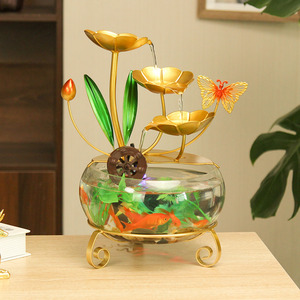(4781 products available)










































































































































































































Tabletop fountain is a small water feature designed to sit on a table or other elevated surface. It typically includes a recirculating pump that moves water over and around various sculptural elements to produce the soothing sounds of flowing water. There are various types of tabletop fountains based on their material, style, and mechanism. Here are some common classifications:
Material Classification:
Tabletop fountains can be made from different materials. Each has its unique look and perks. Metal fountains often use copper, brass, or stainless steel. These materials are strong and give a modern or fancy appearance. Stone and rock fountains use natural materials like slate, granite, or marble, making them look rustic and stable. Ceramic and pottery fountains come in various colors and designs, using durable clay materials. Wood fountains look natural and warm, using treated wood. Acrylic and resin fountains are lightweight and affordable, offering many shapes and styles.
Mechanism Classification:
Fountains with pumps pull water up from a basin so it can flow down again. The pump circulates the water, creating a continuous flow. Solar-powered fountains use solar panels to power the pump, making them energy-efficient and great for outdoors. Wall-mounted fountains save table space by hanging on a wall, suitable for small areas. Candle and lighted fountains combine water with candle or LED light effects for a nice look at night. Decorative fountains focus on appearance with unique designs and embellishments, less on the water sound.
Style Classification:
Fountains come in many styles to fit different tastes. Traditional fountains often have classic designs with bowls, tiers, and spouts. Modern fountains look sleek and simple, with clean lines and minimalism. Zen and Asian-inspired fountains emphasize peace with natural elements and simple designs. Mediterranean-style fountains include tiles, iron, and rustic touches for a warm, southern feel. Tropical or exotic fountains have bright colors and fancy patterns for a lively look.
Style
Tabletop fountains are available in various styles. Each one has a unique look that matches different tastes. Traditional fountains often have classic designs. They include elements like stone, terracotta, or marble. Modern fountains focus on clean lines and minimalism. They may use materials like stainless steel, glass, or ceramic. These materials make them look sleek and contemporary. Asian-inspired fountains incorporate bamboo, slate, or rocks. They create a serene and natural aesthetic. Mediterranean-style fountains often feature vibrant tiles and ornamental accents. They add a warm and rustic touch to the decor.
Materials
Tabletop fountains are made from a variety of materials to suit different preferences and budgets. Common materials include:
- Metal: Metals like brass, copper, and stainless steel are popular for their durability and ability to resist rust. They can be polished for a shiny look or left aged for a more antique appearance.
- Stone and rock: Natural stones and rocks are used in many fountains to create a rustic and earthy feel. They blend well with natural decor and provide a stable base for the fountain.
- Ceramic and pottery: Ceramic fountains can be intricately designed and colored. They add a touch of artistic expression to the space. They are also easy to clean and maintain.
- Wood: Wooden fountains bring warmth and a natural touch to the environment. They are often used in rustic or garden-themed settings.
Water features
All tabletop fountains have several basic water features. They ensure a pleasant sound and visual experience:
- Cascades and tiers: Water cascades down from one level to another in tiered fountains. It creates a soothing sound and a beautiful visual display.
- Streams and spouts: Streams guide water along a defined path. Spouts create arcs of water. Both features add dynamic movement and a pleasing water sound.
Lighting
Some tabletop fountains have built-in lighting to enhance their visual appeal. Common lighting options include:
- LED lights: LEDs are energy-efficient and long-lasting. They come in various colors to highlight the water and fountain features.
- Submersible lights: These lights are placed underwater in the fountain basin. They create a mesmerizing effect as the light filters through the water.
Power source
- Electric pumps: Most tabletop fountains use electric pumps to circulate the water. The pumps come in different sizes to suit the fountain's scale.
- Solar-powered: Solar-powered fountains use solar panels to operate the pump. They are energy-efficient and ideal for outdoor use where sunlight is available.
Adjustability
Many tabletop fountains allow users to adjust the water flow to their liking. It can be done by turning a knob or adjusting a switch. It helps control the sound and water display speed. It makes the fountain more customizable.
Reservoir size
The reservoir or basin size in a tabletop fountain affects how often users must refill it. Larger reservoirs need less frequent refilling. Smaller ones may need more, depending on the evaporation rate and fountain size.
Placement and portability
Tabletop fountains are designed to be portable and easy to place. Some design aspects to consider are:
- Size and weight: Small and lightweight fountains can fit on tables, desks, or shelves without taking up much space. They are suitable for indoor use.
- Power source accessibility: Electric fountains need an electrical outlet nearby. Solar fountains need sunlight exposure. Some fountains have battery-operated pumps for added convenience.
Various industries and businesses can benefit from the beauty of moving water in small spaces. The cascading sounds and sights of the water promote relaxation, reduce stress, and enhance the decor. The following are some usage scenarios for tabletop fountains.
Retail and Showrooms
Retailers and showroom owners can use tabletop fountains to create an inviting atmosphere. The fountain can be placed near the entrance or in key areas to attract customers. The gentle sounds from the fountain can calm shoppers and make them stay longer. It also adds a touch of elegance to the displays.
Restaurants and Cafes
In the food service industry, a fountain can enhance dining experiences. The small water feature can be put on a patio or in a corner inside to mask background noise. The sound of running water can create a peaceful ambiance. It can also be a focal point that increases the customers' interest.
Healthcare Facilities
Hospitals, clinics, and wellness centers can use fountains to reduce stress levels. The soothing sounds of the water can calm patients and visitors. Also, the sight of the moving water can promote healing. Fountains can be placed in waiting rooms, lobbies, or outdoor spaces for a serene environment.
Corporate Offices
Employees can relax in the presence of flowing water thanks to the tabletop fountain. The fountain can be placed in the reception area, conference room, or break room. It can also be used as a decorative piece in retail spaces. The gentle sounds of the water can reduce stress levels and improve concentration.
Spa and Massage Centers
Fountains can enhance the tranquility in spas and massage centers. The moving water is a great addition to massage rooms or relaxation areas. It helps clients to relax and block out noise. The water also helps clients to focus on the treatments. The water feature is also a visual representation of nature, which helps with healing.
Hotel and Hospitality Industry
In hotels and resorts, fountains can create a luxurious experience for guests. The fountain can be placed in the lobby, lobby, or outdoor patio. It can also be used in suites as part of the design. The sound of water can calm guests and make them feel like they are in a sanctuary.
There are some factors that one should consider when choosing the right fountain, which are as follows:
Size and Space:
Before choosing a tabletop fountain, one should consider the available space. Small fountains are suitable for limited spaces like desks or small patios. However, they will need to be seen from a distance to appreciate their beauty fully. Larger fountains will need more space but can be seen from a distance. They usually make a bigger visual impact and produce more sound. Consider the size of the fountain concerning the space one has. Ensure it fits without overwhelming the area.
Style and Aesthetics:
Decide on the preferred style and look of the fountain. Consider the existing decor and the ambiance one wants to create. Do they prefer a modern, rustic, or Asian-inspired design?Select a fountain that matches the taste and complements the environment. A modern metal fountain would look out of place in a country home just as much as a classic tiered stone fountain would in a contemporary garden.
Material:
Tabletop fountains are made from materials like stone, resin, metal, or ceramic. Stone fountains are solid and last long, while resin ones are light and affordable. Metallic fountains look modern, and ceramic ones add a classic touch. The material should match the surroundings and be maintained properly.
Water Sound:
Different fountains produce different water sounds. Some make gentle trickling sounds, while others make louder splashing sounds. Choose a fountain that produces the sound the user wants. If possible, listen to the sound before buying it. Consider the size of the pump when choosing a fountain. A larger pump will produce a louder sound, while a smaller one will produce a softer sound.
Cost:
Set a budget for buying a tabletop fountain. Prices vary based on size, material, and design. Remember that high-quality fountains may cost more initially but will save money in the long run, as they will last longer. Also, consider the cost of electricity to run and the water needed to replace it regularly.
Features:
Some fountains have extra features like LED lights, adjustable water flow, or built-in pumps. These features can enhance the experience and make the fountain easier to use. Choose a fountain with features that are important to the user.
Maintenance:
Consider how easy it is to maintain the fountain. Some fountains need cleaning and water changing more often than others. Ensure it is easy to access the pump and replace the water. Check if any special maintenance is required, like using specific water treatments or cleaning supplies.
Power Source:
Tabletop fountains usually run on electricity, but some can use batteries. Electric fountains provide a consistent water flow, while battery-operated ones are more portable. Consider which power source is more convenient for the location of the fountain.
Q1: Can people leave a tabletop fountain outside?
A1: Most tabletop fountains are designed to be used indoors. Therefore, keeping them outside can damage the product and affect its lifespan. It can also damage the pump, which is usually made to be used in dry conditions only.
Q2: How frequently do people need to top up the water in their tabletop fountains?
A2: In most cases, the water in the fountain should be replenished once a week. However, during hotter seasons, the water may evaporate faster, so it will be needed to top it up more frequently. If the water is not added in time, the pump may become damaged due to dry running.
Q3: What height should a tabletop fountain be?
A3: There is no specific height that a fountain should be placed at. Instead, it should be placed at a height where it can be easily seen and appreciated. The fountain also needs to be placed at a height where it will not be knocked over.
Q4: Do fountains consume a lot of electricity?
A4: Fountains use very little electricity. In fact, they consume a similar amount of electricity that would be consumed by a light bulb. Therefore, they do not add a lot of charges to the electricity bill and are a cost-effective way of enhancing the ambiance of a room.